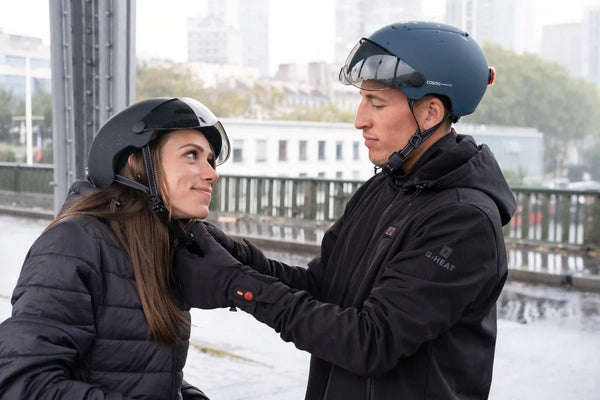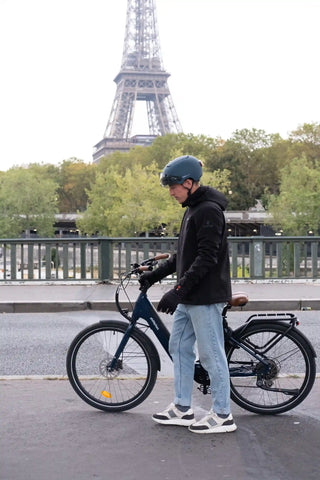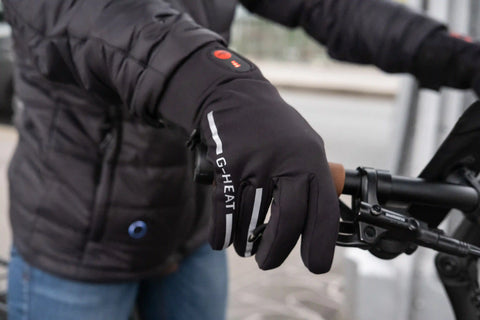
Winter doesn't have to mean hibernation for cycling enthusiasts! With the right equipment and the right reflexes, cycling in winter is not only possible, it's recommended. Opting for cycling for your daily commute helps to improve your health while taking care of the planet. So here's our advice on how to get the most out of your winter cycling.
THE IMPORTANCE OF WARMTH FOR CYCLISTS
PERFORMANCE IMPACT
In winter, temperatures can drop considerably, and staying warm becomes essential for any cyclist.
When the body is exposed to cold, its performance can be seriously affected. Muscles contract to generate heat, which can lead to reduced flexibility and strength, affecting the ability to pedal efficiently.
IMPACT ON WELL-BEING
In addition to the purely physical aspect, a cyclist's mental well-being can also be affected by the cold. Riding in extreme cold conditions can be uncomfortable, even painful, which can diminish the pleasure of the activity and even discourage some bikers.
PROTECTING THE UPPER BODY
To counteract these negative effects, it's crucial to protect the upper body with suitable clothing. Good thermal insulation is essential to maintain body temperature and guarantee optimum performance.
PROTECTING THE LOWER BODY
Similarly, the lower body must be effectively protected. Legs and feet are particularly sensitive to the cold, and appropriate cycling gear is needed to ensure comfort and functionality while riding.
THE BEST WINTER CYCLING APPAREL: MTB, ROAD OR HYBRID
THERMAL JERSEYS AND TECHNICAL UNDERWEAR: KEEP THE HEAT CLOSE TO YOUR BODY
To brave the rigors of winter, it's important to invest in quality thermal clothing. Technical undergarments, such as jerseys and tights, are renowned for keeping your body warm and wicking away perspiration. Made from insulating and breathable materials, these garments offer the perfect balance between comfort and performance.
When choosing your underwear, opt for moisture-wicking fabrics to keep you dry and warm throughout your outing. Synthetic fabrics such as polyester or polypropylene are ideal, as they are highly efficient at wicking away perspiration.
Thermal jerseys are specially designed to lock in body heat while wicking away moisture. Choose fitted models that hug the contours of your body without compressing it, ensuring optimal insulation.
Among the many items of clothing available for cyclists, winter underwear plays a key role in protecting against the cold. Acting like a second skin, they protect the most sensitive parts of the cyclist's body, such as the feet and back. Materials commonly used in the manufacture of jerseys, such as polyester and merino wool, offer additional benefits such as enhanced breathability, antibacterial and anti-odour properties, while maintaining body heat.
LONG SHORTS: PERFORMANCE AND COMFORT
Choose long shorts or leggings for your winter cycling outings to keep your legs warm. Made from warm, breathable materials, they provide effective protection while allowing the skin to breathe. Their elasticity guarantees a perfect fit for all morphologies, ensuring optimum comfort. Ankle-length shorts offer complete protection, preventing draughts and enhancing comfort. The long shorts also provide extra muscle support, recommended for long distances.
JACKETS
Investing in a waterproof, breathable jacket is essential to protect you from the rain while allowing perspiration to escape. Make sure it has taped seams and waterproof zippers for added protection.
The choice of model depends on a number of factors, including temperature and humidity. From sleeveless options to long fleece-lined jackets, these outfits offer effective protection against icy wind and rain, thanks to their adjustable waterproof levels.
Some models use Softshell technology, making the jackets hydrophobic to repel raindrops while ensuring optimum breathability. In addition, manufacturers incorporate breathable materials and ventilation systems to guarantee your comfort during effort.
HEATED CYCLING JACKETS
Heated jackets use advanced technologies to maintain constant warmth, offering protection against extreme temperatures. The G-Heat heated softshell jacket provides superior thermal comfort on the move, ensuring a pleasant riding experience even in freezing weather. With up to 8 hours of autonomy, it warms your body in 5 zones for continuous, comfortable warmth.

ACCESSORIES FOR MOUNTAIN BIKING, ROAD RIDING AND HYBRIDS IN WINTER
GLOVES FOR WINTER CYCLING
The hands, the first to come into contact with the wind, are the extremities most exposed to the cold. When they're numb from the cold, it becomes difficult to use your fingers to maneuver the handlebars or brake. Choose insulating, waterproof gloves to protect your hands from the cold and damp, while ensuring easy handling of your bike's handlebars.
HEATED CYCLING GLOVES: KEEP YOUR HANDS WARM FOR BETTER PERFORMANCE
Designed to effectively combat the cold when cycling, G-Heat heated cycling gloves use cutting-edge technology to provide optimum comfort. With heat distributed to the top of the hand and fingertips, and powered by a rechargeable battery, the temperature inside the gloves remains constant. Thermal regulation is adjustable thanks to three heating modes (high, medium and low), offering cyclists the possibility of adapting the heat to their needs. Depending on the mode selected, the autonomy of the heated gloves varies between 3 and 7 hours, ensuring prolonged use for safe, warm rides.
Made with a triple-layer construction, these heated cycling gloves provide optimum insulation against the cold and waterproof protection thanks to their breathable membrane. Their ergonomic design guarantees a perfect fit and ease of donning, even in cold weather, while the fleece inner membrane offers added comfort and protection against the winter elements. Their multi-layer structure moulds to the shape of the hands, preventing cold air from penetrating and offering protection down to -10 degrees thanks to their heating technology, for optimum warmth in all conditions.
Equipped with tactile surfaces on the tips of the thumb and forefinger, the gloves make it easy to use smartphones while you're on the move. High-visibility options with reflective strips enhance your safety and visibility on the road, while combating the winter cold.

Your cycling gloves can also be combined with heated under-gloves for extra warmth and defense against the cold.
SOCKS FOR RIDING IN THE COLD OR RAIN
Technical socks designed specifically for winter cycling are an essential piece of equipment, providing extra thermal insulation while wicking moisture away to keep feet dry and warm. To meet cyclists' needs, manufacturers use blends of elastic, waterproof, breathable and thermally insulating materials such as merino wool, nylon and elastane.
G-Heat offers innovative heated socks to keep cyclists' feet warm. They offer a soft, even feeling of warmth thanks to carbon fibers, with 3 temperature settings to suit individual needs. By keeping feet warm, these socks enhance sporting performance in cold weather, ensuring optimum comfort right down to the toes. The Outdoor V2 model lets you control sock temperature by remote control.
HEATED INSOLES G-HEAT : OPTIMAL COMFORT FOR WINTER CYCLING
Ultralight heated insoles are designed with an ergonomic shape that perfectly follows the curve of the foot, offering superior comfort to its user, especially those suffering from Raynaud's disease.
They ensure constant warmth, particularly beneficial for keeping feet and toes warm during winter cycling outings. Available with a rechargeable battery, these insoles offer great flexibility. Thanks to a wireless remote control, you can easily adjust the heat distribution to suit your preferences. What's more, they are customizable in size, ensuring a perfect fit for every user.
ESSENTIAL ACCESSORIES
- Goggles: protect your eyes from wind, rain and debris. Choose tinted lenses to enhance your vision on sunny days, and clear lenses for dark or rainy conditions.
- Waterproof bags: transport your belongings without the risk of humidity. Make sure they're big enough to hold your belongings, yet waterproof enough to protect their contents from the rain.
- Anti-cold cream: protect your skin from harsh conditions by applying it to exposed areas of your skin, such as your face and hands. Choose a Vaseline- or lanolin-based cream for optimum protection against cold and wind.
OUR TIPS FOR SAFE WINTER DRIVING
MAINTAINING YOUR BIKE IN WINTER
SPECIAL LUBRICANTS: PROTECTING YOUR BIKE'S COMPONENTS AGAINST CORROSION
Use special lubricants to protect your bike's components from corrosion caused by moisture and road salt. Apply them regularly to keep your bike in good working order throughout the winter season.
ADAPTED TIRES: IMPROVE GRIP ON SLIPPERY ROADS
For safe winter driving, opt for tires specially designed for winter conditions, with a tread pattern adapted for better grip on slippery roads. Be sure to check tire pressure regularly to maintain stable, safe driving. We recommend slightly reducing the recommended inflation pressure to improve road grip. In snowy or wet conditions, consider slightly wider or studded tires. Protect your tires with a bike cover and park them indoors if possible to preserve their quality.
CHECKED BRAKES: GUARANTEE SAFE STOPPING EVEN ON WET SURFACES
Make sure your brakes are in good working order before every winter outing to ensure safe stopping, even on wet or slippery surfaces. Check brake pads for wear and replace them if necessary for optimum efficiency.
ADAPTING TO CYCLING
During winter journeys, reduce your speed and give yourself more time. Drive carefully to anticipate obstacles and avoid falls. Slow down especially at intersections and around dangerous areas such as manhole covers.
Use bicycle lanes whenever possible, and be even more careful if you have to use a snow-covered path. Adapt your speed to the weather conditions and avoid areas where the snow is compacted, as it can be more slippery. Also beware of icy patches and, when descending, dismount to reduce the risk of falling.
ADAPTING LIGHTING AND VISIBILITY
FRONT AND REAR LIGHTS: BE SEEN, BE SAFE
In winter, the days are shorter and visibility can be reduced, so it's important to be well lit to be seen by other road users.
LED LAMPS: POWER AND EFFICIENCY
Choose powerful LED lights for your bike, with flashing modes to increase your visibility. Make sure they're charged before each ride to avoid unpleasant surprises.
REFLECTORS AND REFLECTIVE STRIPS: INCREASING YOUR VISIBILITY
Install reflectors and reflective strips on your bike and equipment to increase your visibility, especially on dark or rainy days.
FAQ
1. IS IT DANGEROUS TO CYCLE IN WINTER?
Riding in winter can present additional challenges due to the cold and variable weather conditions, but by being well equipped and careful, it can be done safely.
2. DO I NEED SPECIAL TIRES FOR WINTER DRIVING?
We recommend using tires suitable for winter cycling, with tread designed to improve grip on slippery roads.
3. HOW CAN I PROTECT MY BIKE FROM CORROSION IN WINTER?
Use special lubricants to protect your bike's components from corrosion caused by moisture and road salt. Apply them regularly to keep your bike in good working order.
4. WHAT ARE THE DANGERS OF DRIVING IN THE RAIN?
Riding in the rain can reduce visibility and increase the risk of slipping. Make sure you're well equipped with waterproof clothing and traffic lights to increase your safety.
5. HOW CAN I STAY WARM DURING MY WINTER CYCLING OUTINGS?
Wear quality thermal clothing, insulated gloves and waterproof overshoes to protect you from the cold and damp during your winter journeys.


